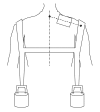Altered neuromuscular control mechanisms of the trapezius muscle in fibromyalgia
- PMID: 20205731
- PMCID: PMC2839982
- DOI: 10.1186/1471-2474-11-42
Altered neuromuscular control mechanisms of the trapezius muscle in fibromyalgia
Abstract
Background: fibromyalgia is a relatively common condition with widespread pain and pressure allodynia, but unknown aetiology. For decades, the association between motor control strategies and chronic pain has been a topic for debate. One long held functional neuromuscular control mechanism is differential activation between regions within a single muscle. The aim of this study was to investigate differences in neuromuscular control, i.e. differential activation, between myalgic trapezius in fibromyalgia patients and healthy controls.
Methods: 27 fibromyalgia patients and 30 healthy controls performed 3 minutes bilateral shoulder elevations with different loads (0-4 Kg) with a high-density surface electromyographical (EMG) grid placed above the upper trapezius. Differential activation was quantified by the power spectral median frequency of the difference in EMG amplitude between the cranial and caudal parts of the upper trapezius. The average duration of the differential activation was described by the inverse of the median frequency of the differential activations.
Results: the median frequency of the differential activations was significantly lower, and the average duration of the differential activations significantly longer in fibromyalgia compared with controls at the two lowest load levels (0-1 Kg) (p < 0.04), but not at the two highest load levels (2 and 4 Kg).
Conclusion: these findings illustrate a different neuromuscular control between fibromyalgia patients and healthy controls during a low load functional task, either sustaining or resulting from the chronic painful condition. The findings may have clinical relevance for rehabilitation strategies for fibromyalgia.
Figures




Similar articles
-
The relation between neuromuscular control and pain intensity in fibromyalgia.J Electromyogr Kinesiol. 2011 Jun;21(3):519-24. doi: 10.1016/j.jelekin.2011.01.004. Epub 2011 Feb 18. J Electromyogr Kinesiol. 2011. PMID: 21333549
-
Adaptations of upper trapezius muscle activity during sustained contractions in women with fibromyalgia.J Electromyogr Kinesiol. 2010 Jun;20(3):457-64. doi: 10.1016/j.jelekin.2009.07.002. Epub 2009 Aug 13. J Electromyogr Kinesiol. 2010. PMID: 19682926
-
Firing rate and conduction velocity of single motor units in the trapezius muscle in fibromyalgia patients and healthy controls.J Electromyogr Kinesiol. 2008 Oct;18(5):707-16. doi: 10.1016/j.jelekin.2007.02.016. Epub 2007 Apr 24. J Electromyogr Kinesiol. 2008. PMID: 17459728
-
Alterations in shoulder kinematics and associated muscle activity in people with symptoms of shoulder impingement.Phys Ther. 2000 Mar;80(3):276-91. Phys Ther. 2000. PMID: 10696154 Review.
-
The extraction of neural strategies from the surface EMG.J Appl Physiol (1985). 2004 Apr;96(4):1486-95. doi: 10.1152/japplphysiol.01070.2003. J Appl Physiol (1985). 2004. PMID: 15016793 Review.
Cited by
-
Controlled, cross-sectional, multi-center study of physical capacity and associated factors in women with fibromyalgia.BMC Musculoskelet Disord. 2018 Apr 19;19(1):121. doi: 10.1186/s12891-018-2047-1. BMC Musculoskelet Disord. 2018. PMID: 29673356 Free PMC article. Clinical Trial.
-
Latent myofascial trigger points.Curr Pain Headache Rep. 2011 Oct;15(5):386-92. doi: 10.1007/s11916-011-0210-6. Curr Pain Headache Rep. 2011. PMID: 21559783 Review.
-
Human myoelectric spatial patterns differ among lower limb muscles and locomotion speeds.Physiol Rep. 2020 Dec;8(23):e14652. doi: 10.14814/phy2.14652. Physiol Rep. 2020. PMID: 33278064 Free PMC article.
-
Upper limb position control in fibromyalgia.BMC Musculoskelet Disord. 2012 Sep 24;13:186. doi: 10.1186/1471-2474-13-186. BMC Musculoskelet Disord. 2012. PMID: 23006674 Free PMC article.
-
Alterations of anti-inflammatory lipids in plasma from women with chronic widespread pain - a case control study.Lipids Health Dis. 2017 Jun 12;16(1):112. doi: 10.1186/s12944-017-0505-7. Lipids Health Dis. 2017. PMID: 28606089 Free PMC article.
References
-
- Lawrence RC, Helmick CG, Arnett FC, Deyo RA, Felson DT, Giannini EH, Heyse SP, Hirsch R, Hochberg MC, Hunder GG, Liang MH, Pillemer SR, Steen VD, Wolfe F. Estimates of the prevalence of arthritis and selected musculoskeletal disorders in the United States. Arthritis and Rheumatism. 1998;41:778–799. doi: 10.1002/1529-0131(199805)41:5<778::AID-ART4>3.0.CO;2-V. - DOI - PubMed
-
- White KP, Speechley M, Harth M, Ostbye T. The London fibromyalgia epidemiology study: Comparing the demographic and clinical characteristics in 100 random community cases of fibromyalgia versus controls. Journal of Rheumatology. 1999;26:1577–1585. - PubMed
Publication types
MeSH terms
LinkOut - more resources
Full Text Sources
Medical

